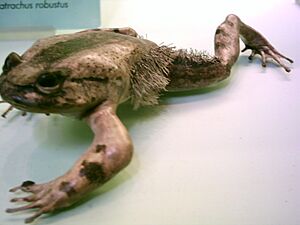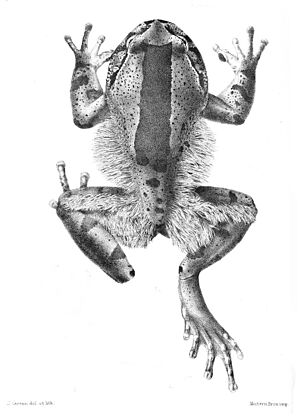Hairy frog facts for kids
Quick facts for kids Hairy frog |
|
|---|---|
 |
|
| Male, showing hair-like papillae | |
| Conservation status | |
| Scientific classification | |
| Genus: |
Trichobatrachus
|
| Species: |
robustus
|
| Synonyms | |
|
Astylosternus robustus |
|
The hairy frog (Trichobatrachus robustus) is a super interesting frog from Central Africa. It's also known as the horror frog or Wolverine frog because of its unique features! This frog gets its common name from the hair-like structures found on the body and legs of the male frogs. It belongs to the Arthroleptidae family of frogs.
Contents
Amazing Features of the Hairy Frog
What Does a Hairy Frog Look Like?
Male hairy frogs are usually about 10 to 13 centimeters (4 to 5 inches) long. Females are a bit smaller, around 8 to 11 centimeters (3 to 4 inches) long. They have a large, wide head with a short, rounded snout.
Why Do They Have "Hair"?
Breeding male hairy frogs grow special hair-like structures on their sides and thighs. These aren't real hair like on a mammal. Instead, they are soft, skin-like bumps called dermal papillae. These "hairs" have tiny arteries inside them. Scientists believe they help the frog absorb more oxygen from the water. This is very helpful because the male frog stays with his eggs in the water for a long time after the female lays them.
How Do Hairy Frogs Reproduce?
Hairy frogs usually live on land. But when it's time to lay eggs, they go back to the water. The female lays her eggs on rocks in streams. The baby frogs, called tadpoles, are quite muscular. They eat other small animals and have several rows of tough teeth.
What Do Hairy Frogs Eat?
Adult hairy frogs are carnivorous, meaning they eat meat. Their diet includes slugs, myriapods (like millipedes), spiders, beetles, and grasshoppers.
The Hairy Frog's "Claws"
One of the most amazing things about the hairy frog is its special "claws." These aren't true claws like you'd see on a cat or dog. Instead, they are made of bone, not keratin (the material in our fingernails). When the frog feels threatened or is attacked, it can push these sharp bones through its skin! It seems to do this by intentionally breaking the bones in its toes.
There's also a small bony piece near the tip of each toe. When the "claw" is not in use, it's connected to this piece by strong fibers. When the frog pushes the claw out, it breaks this connection. Scientists aren't sure how the claws go back inside. One idea is that they just pull back on their own, and the damaged skin then heals. This unique defense mechanism is very rare in the animal kingdom!
Where Do Hairy Frogs Live?
Hairy frogs are found in several countries in Africa. You can find them in Cameroon, the Democratic Republic of the Congo, Equatorial Guinea, Gabon, Nigeria, and Angola. They like to live near fast-flowing rivers in forests. They can also be found in farming areas that still have some tree cover, like plantations.
Are Hairy Frogs in Danger?
The hairy frog species is facing some challenges. Their homes are being lost due to habitat loss. Pollution also affects them. People sometimes hunt them for food, and a few are caught for the pet trade. They might also be affected by a frog disease called chytridiomycosis. Even though some groups of hairy frogs are getting smaller, the species lives across a large area. Because of this, it is not currently considered an endangered species overall.
Hairy Frogs and People
In Cameroon, hairy frogs are sometimes caught and eaten. People hunt them using long spears or machetes. The Bakossi people, who live in Cameroon, have a traditional belief about these frogs. They used to think that the frogs fell from the sky. They also believed that eating these frogs could help couples who couldn't have children become fertile.
See also



